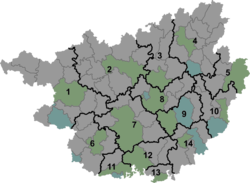Longbang
龙邦镇 | |
|---|---|
| Coordinates: 22°53′N 106°20′E / 22.883°N 106.333°E | |
| Country | People's Republic of China |
| Autonomous Region | Guangxi |
| Prefecture-level city | Baise |
| County-level city | Jingxi |
| Area | |
| • Town | 119 km2 (46 sq mi) |
| Population (2012)[1] | |
| • Town | 20,378 |
| • Density | 170/km2 (440/sq mi) |
| • Rural | 18,123 |
| Time zone | UTC+8 (China Standard) |
Longbang (Chinese: 龙邦) is a town in Jingxi, Guangxi of China.[2] As of 2018[update], it has 12 villages under its administration.[3]
Most of its residents speak Zhuang dialects.[4] Its main touristic sight are the Pogala underground defense works, an underground fortification built in 1892.[5][6]
It is located near China's border with Vietnam, opposite the Trà Lĩnh District on the Vietnamese side.
Border crossing
[edit]At the Longbang Border Crossing (龙邦口岸) (22°52′N 106°20′E / 22.867°N 106.333°E) just south of town, Guangxi provincial highway 210 (S210) reaches the international border. There are also plans to extend the Tiandong-Debao rail line (a branch of the Nanning-Kunming Railway) to the Longbang border crossing.[7]
According to a local travel guide site, there is a large market near the border crossing, where goods imported from Vietnam are sold.[8]
References
[edit]- ^ a b "靖西市龙邦镇". 2015-11-15.
- ^ 2018年统计用区划代码和城乡划分代码:靖西市 (in Chinese). National Bureau of Statistics of the People's Republic of China. Retrieved 2019-03-04.
- ^ 2018年统计用区划代码和城乡划分代码:龙邦镇 (in Chinese). National Bureau of Statistics of the People's Republic of China. Retrieved 2019-03-04.
- ^ 龚心瀚 (1993). 边境贸易实务手册 (in Chinese). 上海远东出版社. ISBN 978-7-80514-960-8.
- ^ 北京六廠二校經驗選編. 香港三聯書店. 1970.
- ^ 中国民族年鉴 (in Chinese). 民族出版社. 2004.
- ^ Wang Gang (王刚) (2010-07-24), 泛亚铁路东通道重要路段广西开通 延伸至中越边境 (An important section of the Transasian Railway's Eastern Route; to extend to the Sino-Vietnamese border)
- ^ Jingxi County - shopping Archived 2011-07-18 at the Wayback Machine

Well, that’s interesting to know that Psilotum nudum are known as whisk ferns. Psilotum nudum is the commoner species of the two. While the P. flaccidum is a rare species and is found in the tropical islands. Both the species are usually epiphytic in habit and grow upon tree ferns. These species may also be terrestrial and grow in humus or in the crevices of the rocks.
View the detailed Guide of Psilotum nudum: Detailed Study Of Psilotum Nudum (Whisk Fern), Classification, Anatomy, Reproduction